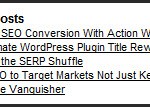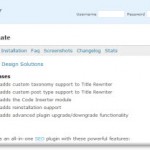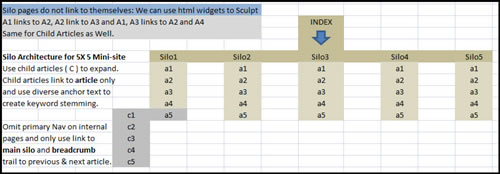I would like to share a simple SEO siloing technique for WordPress that you can use to theme and silo your content to achieve higher search engine rankings. Theming implies creating a collective series of posts based on a similar semantic node.
Siloing involves creating a process of selective categorization to create a topical website within a site to collectively concentrate ranking factor to a specific page (as the apex of the silo). This apex is the new preferred landing page for the theme / “primary keyword”.
As a preferred page, it should only contain the primary keywords you intend to rank the pages it links to in the anchor text. For example, a typical category page in a properly optimized e-commerce site will have a category and then feature brands of that type of product.
Once you select a brand, then all of the makes and models of products from that mfg. are presented, or should be presented in links to the respective internal faceted pages.
By the webmaster mirroring intent and using modifiers buyers use in combination with the brand, make or model in the title, h1 tags, contextual content and internal links (from page to page), a webmaster can create nested pages in that silo that correspond to the most popular searches.
When you augment the primary category landing page (theme) with a series of semantically aligned make, model or product pages (using the brand/mfg. name as the primary thread) this layering of pages create a very distinct type of ranking factor.
This compound effect resulting from the body of documents is a powerful ranking arsenal against competitors and works like a self-supporting algorithmic daisy chain using the buddy system to catapult keywords and their respective landing pages in to the spotlight in search engines.
While the example below is based on a simple theme using 5 siloed posts, you can see how this could be applied on a larger scale (such as Wikipedia or Amazon) by implementing a few simple rules in the site architecture, URL / naming conventions and internal links collectively.
How to Easily Implement Siloing
STEP 1: Permalinks
Set up the permalinks using /%category%/%postname%/ in the permalinks settings page using the custom option.
STEP 2: Category Selection
Create your categories (which should be keywords you want to rank for that have over 2,000,000 competing pages or more. For example, if you wanted to rank for best affiliate programs, then you would create a category called “best affiliate programs” (then build nested content in the category as silos) to reinforce the keyword.
Ideally, you would use at least 5 other related or synonymous keywords or keyword variations as part of the semantic cluster such as:
- best paying affiliate programs
- top affiliate programs
- best affiliate networks
- review affiliate programs
- best affiliate software
The critical thing is that all of the keywords used for posts under the main category are (a) related preferably with the shingles (group of words) based on the target phrase using modifiers and other popular search terms and (b) that each of those pages in the silo all link to the primary preferred landing page (more on that next).
STEP 3: Create Landing Page and Links
Since WordPress is automatically programmed with pages to take precedence over posts, create a page named the exact same thing as your category – i.e “best affiliate programs”. This page will now override the category (which would have been a cyclical page with the nested posts on it).
Now, as a result of the supporting content in the silo, this new page is a powerful landing page which you can showcase your primary keyword, the value proposition, sales copy or conversion objective to facilitate rankings and sales.
Over time, as a result of the internal links from the nested (siloed) pages, the theme (best affiliate programs) a.k.a the category will start to develop authority as a result of the pooling link flow bubbling up from the internal “related” pages.
To create continuity you could (1) build links to the internal siloed pages or (2) build links to the preferred landing page (with the variations of keywords found in the siloed post).
Over time, the landing page will rank for its primary “more competitive” key phrase and any possible variation that is passing on its ranking credit as a result of being linked within the silos.
Ideally, on the siloed pages, you can create a custom page that omits the primary navigation, this way it forces the link flow to move a certain way throughout the site (through the contextual links on the page).
Your website scales relevance while gaining traction as a semantically themed keyword cluster and using a simple plugin like SEO Ultimate and the Deeplink Juggernaut, you can add autolinks automatically within content based on any occurrence of a keyword on any page within the silo. You can download SEO Ultimate from WordPress.
In this instance, any time the word affiliate program is mentioned, you could have it auto-linked to the preferred landing page.
To summarize, rinse and repeat this up to 15 themes per website and ensure that the silos are at least 5 posts deep. Make sure you have a new “Page” to create a capstone for the category and make sure you are building deep links from other websites to augment the pages in the theme or silo.
That’s it. Enjoy the power of nesting topical content in categorized silos and leveraging the power of internal links to funnel link-flow throughout your posts and outrank your competition using the power of on page optimization and site architecture to your advantage.











They’re some good tips. We’re going to try to implement some of them.
Great tips! I was missing the critical part of replacing the default category with a landing page when siloing my websites. I am using the WP No Category Base plugin to remove /category/ from the URL so that I can override the category with a static page.
I have one question about navigation. Since the default category is overridden with a static page, how can a user navigate to the child articles (c1-c5 in the image) from the root index page? Usually, they would go to the base of the category from the main navigation menu and see all the posts listed there. Any suggestions?
Thanks!
@Dan:
Thanks.
@Phil:
There are a number of ways to channel link flow.
For example (1) you can use a related posts plugin and have it pull results only from that category (2) use the html widget area and use text link in block text or contextual links to add targeted navigation(3) breadcrumbs or (4) an html sitemap linked form the footer of the siloed pages.
Hope this helps
Loved the article. Thanks for the follow up to Phil. I had a similar question because some of my silos are set up with pages, but I have about 6 or 7 categories that are more random.
That leaves me to a question I wonder if others are thinking. What if the category names/urls were not properly optimized? Should you then start a new category and redirect old post, start a new category and start from scratch? I am referring to about 100 posts not just a few.
@Joseph:
Regarding your question – “What if the category names/urls were not properly optimized? Should you then start a new category and redirect old post, start a new category and start from scratch? I am referring to about 100 posts not just a few”…
I would suggest that by using a plugin such as “no category parents” – http://juniorhero.com/remove-wordpress-category-base “thanks Athul” which will remove the category and perform internal redirects without a hiccup.
Or you can use SEO Ultimate and use the title re-writer to change the output of the post URL (without actually rewriting it).
Ideally, starting with the site architecture first and building your silos properly is preferred, but there are still options.
Also, if you update your Permalinks format, the changes you make there will override the URL data and reroute things based on WordPress’s core code.
Very, very interesting. Thanks for this information. I do have a question though; does this technique work against any of the WordPress plugins that are out there that provide internal linking on sites?
Siloing enhances on page optimization, internal linking combined with relevant tiered or themed site architecture is extremely effective for capturing entire clusters of keywords (not just the ones you’re targeting) but all of the layers in the silos.
Wow. Seriously well written explanation of an advanced concept in SEO. Well done!
Jeff Yablon
Very clear article! Thank you!
Your blog showcases the best SEO explanation I’ve found in 2 years. Thanks for sharing. I just wish the Deeplink Juggernault would work on my installation… I’m still getting coding errors with the latest 4.7.1 version.
@Fred: What error messages are you getting?
@John Lamansky:
Warning: Wrong parameter count for array_slice() … content-autolinks.php on line 167 (I get this one twice) and
Fatal error: Unsupported operand types … content-autolinks.php on line 178
Thnaks for your help!
Thanks for the advice Jeffrey
In addition to breadcrumbs, I ended up writing a simple contextual widget in the sidebar to help users navigate to a upper category level. Basically, when viewing a category that has child categories, it lists all the children of that category in the sidebar (up to 1 level of depth only). If the current category has no children, it lists the posts in that category. When viewing a single page or post, the widget is not visible. Works wonderfully, can’t wait to see how well this site does in the SERPs.
Happy new year!
This is a new concept for me and I’m struggling just a little.
Say I have “online widgets” as my targeted key phrase. I create a category and a PAGE (not a post) with the name “Online Widgets”. This is my main landing page.
Now I start my silos. I choose “buy online widgets”, “best online widgets” and “new online widgets”. I create PAGES ( again not posts) for each of these.
Since pages don’t show up in categories, how do I get the links from the main page to the 3 sub-pages? After that, how do I get the supporting POSTS for each silo sub-page to be reflected on the menu system?
Is this going to require some custom programming of my theme?
@Jim:
After you create the category and landing page (using a page). The top of the theme is finished.
For your siloed pages (best, new, etc.) Those should be “posts” not pages. As posts, simply assign them to the category and they are now supporting articles/silos to the theme.
If you use pages for the supporting articles, they will be lateral (flat) in the navigation schema of the site architecture vs. vertical or nested under the theme/category.
Hope this helps…
*An interesting discussion is worth comment. I think that you should write more on this topic, it might not be a taboo subject but generally people are not enough to speak on such topics. To the next. Cheers
Jeffrey,
Thanks for the feedback. I think I’ve got it now.
Using my original widgets example, “online widgets” is my category and landing page. Then, I write several posts using my supporting topics, “best, new, etc” and assign them to the main category.
I was making the mistake of creating a sub category for each of my supporting topics, then trying to write 5 posts about each of the supporting topics. In essence I was creating sub silos to support the main theme.
As usual, I was over analyzing and complicating things more than needed
I have something on my mind that I can’t find an answer for.
I have a website about, let’s say, red chicken. The first silo I want to create is for the subject/keyword “red chicken”. I put some pages of content in that silo and link it all together with related keywords/subject of pages of content.
Now I wonder, is it better to have my main keyword “red chicken” pointing to my homepage or the base page of the main silo which also is about the keyword “red chicken”? This dilemma does not apply to other silos, just the one that has the same keyword as the homepage.
Hey Fred:
Usually, your homepage should be the most competitive root phrase of the theme. For example, since you said red chicken, the main theme / homepage should rank for “chicken” then link to the red chicken “landing page/silo”.
That way the page most suited for conversion is presented in the search engine result pages – which leads to higher conversions and user satisfaction. Ultimately, what good is SEO if the traffic does not convert?
The balance between optimization and ROI are both inherent with this type of theming and siloing.
Hope that helps.
Jeffrey
Thank you for the advice, Jeffrey, just something I have to clarify: On my site site I use noindex robots settings for categories. When using WP No Category Base plugin and your method above (overriding the category with the static page) I should see the static page instead of category posts (excerpts)when clicking on category? Should I continue using the noindex settings for categories in this setup? Hope I am being clear..
Thank you,
Jemma
Hi Jemma:
Since the “category” default archives page is no longer prevalent as a result of creating a “page” named the same as the category, there should be no negative side effects of using this method. The only thing nofollowed now is that category (if you did not have the page in place). Then if you link up to the new page or use an automatic linking plugin, the new page that replaces the category will take off in the SERPs and become buoyant.
Hope this helps!
All the best
Does anyone recommend using any of the Silo plugins available for WordPress? Are these necessary?
-Ella
Hi Jeffrey,
I am looking to put this into action on my blog, but can you clarify about the pages and categories part of your post
” Since WordPress is automatically programmed with pages to take precedence over posts, create a page named the exact same thing as your category – i.e “best affiliate programs”. This page will now override the category (which would have been a cyclical page with the nested posts on it)”
Should I be displaying categories on my side bar with your method or not ?. As it stands if I click on a category,I still see the posts listed. Should all my posts be displaying on the landing page ( silo ) as I build them out ? The set up your explain is easy to follow, I am just not sure how the page is taking precedence over posts.
Thanks
Josh
Hi Jeffrey,
This may be the best SEO blog I have come across in my short but fairly intensive 8 months of online marketing.
I have a question if you don’t mind:
I am having the same problem it sounds like Josh posted on March 18: I tried creating a Category Landing Page by creating a Page with the same name as an existing Category on an old site I have and the Page is not taking priority.
Any idea what may be happening?
thanks
Kevin
Check and see if you have any plugins preventing a category base rewrite, or make sure the page is the exact same as the category and it should override the post in WordPress…
Not fully understanding what you meant by “category base rewrite” I assumed you meant something like the “No category parents” plugin and yes by deactivating that it now works.
thanks!
Hey Jeffrey, many thanks for your great posts here.
I’m a recent convert to the excellent SEO Ultimate plugin after hearing JamesTheJust from http://theaveragegenius.net raving about this for months now.
I’ve been trying to “silo” my site based on your recommendation in this post and I’ve created a landing page for my category named the same as my category….so, I no longer have the default WP archive page showing older posts but rather a page of content.
The problem is I have to deactivate the WP No category base plugin in order to see the static page instead of the default category posts.
I want to carry on using the WP No category base because I have used this from the beginning and my site now has over 100 posts and I have been building links to these posts.
I want to set up my silo structure as you recommend in this post but I can’t because of the conflict.
Do you have any suggestions on how I can get around this?
I’ve been doing more experimenting since my last post here and have discovered the following problems – when I use the SEO Ultimate plugin and enable the Siloed Categories widget and deactivate the WP No Category Base plugin, I get my silo landing page showing (instead of the default category archive page) which is what I want BUT the Siloed Categories does not work.
I see the top-level categories but when I click on a category I no longer see the posts nested underneath that category. (Which is what Siloed Categories did so beautifully).
If I activate the WP No Category base (which I have had on my site since its inception) and use SEOU with Siloed Categories enabled, my silo landing page no longer shows although the siloed categories work fine ie I see a list of related posts within a category when I select it.
I want to have my silo landing pages showing and I also want the siloed categories to work (as well as to have the WP No category base plugin activated).
Any ideas on what could be going wrong or how to clear up the conflict?
Would appreciate your help – many thanks.
Tara
I’ve learned a lot from this blog, I’m wondering about implementing a dropdown navigation menu – I really want this for user-experience and from a marketing standpoint, but I don’t want to spread out the PR from the main blog… across the subpages 2 or 3 levels deep…
Example:
Beachbody Coaching Opportunity
– Beachbody Marketing Tools
— Free Beachbody Blog
— Free Beachbody Blog Hosting
…etc…
All of these links show in my menu bar, but do I need to add rel canonical, or nofollow, or something to these links, so that Google will ONLY follow them
when at mysite.com/Beachbody-Coaching-Opportunity
What is the best way of doing the multiple level dropdowns AND properly use SEO siloing?
You can use Javascript for the dropdowns (so search engines do not see them) then link contextually from the body area feeding only theme relevant pages. Using the script will allow you to (a) serve the user and (b) not have to worry about hemorrhaging link juice.
Excellent explanation and excellent SEO Plugin as well, I LOVE IT..
I have a question about Deep Link Juggernaut…
What if I want to ‘deep link’ a 3-word phrase instead of a single word, do I need to add quotes in the Anchor Text field?
Thanks
Dave
@Dave:
Hi Dave, just add the three words and tell it which page to build the link to. It will only engage if it finds those three words, not one or two of them not in sequence.
Enjoy!
Interesting. I see you state that pages will override categories. I have set the same name to a page and a category and the same url slug. I have set to tweak the permalink so to remove/category/ from the url but still the page does not override the category. The category is prominent and it’s where the links take me to. I am using Catalyst Theme in case that makes any difference.
Jeffery,
Good stuff here..thanks alot. I’m implementing by making category and landing the same name. But WP automatically places a -2 after the category name after I select Add Category. So now the page url and category slug are different. Is this normal? If so, which do I link to from my child posts?
Thanks
Hi there, Jeffrey:
I am having a little problem here and I hope you can help.
In step 3, you said:
“create a page named the exact same thing as your category”
I can create a page with the same NAME (I created a category called Test Category and a Page called Test Category) but the slugs are changed automatically.
The Category page slug is testcategory but when I create the Page, wordpress inserts a hyphen and calls it test-category.
Is that going to be a problem, and if so, is there any way to work around this?
Also, how do I assign the posts to the PAGE that I have created? Will I have to do it by hand (i.e., hard coding everything)?
Is it because wordpress is inserting a hyphen and changing the page slug to test-category that no posts are being inserted?
Or am I missing something?
Hi Justine:
You can change the slug in the top right dropdown on the page select slugs, then edit the page slug. See if you can create both then. After that, if you use SEO Ultimate you can choose the URL conflict resolution setting in the Misc. section from the modules, then select page over term archive. Essentially, the page will trump the category or post with same name. Then, when you add nested content under the post/category the page gets the juice (if internally linked).
However, since this time, we have created a plugin that can do everything you need. But you will need a subscription to DWS for it. http://www.networkempire.com/
Jeffrey,
Hi. Great info. on site siloing. Still semi new, and trying to use this in my current, and hopefully new sites. Hopeing I could get your input on one item…
Am using wordpress, you know how on the sidebar you can show Recent Posts and Categories… Would it be better to not show Recent Posts (or any posts) in the sidebar navigation? Wondering if this would dilute the silos a little.
~thanks
It does allow theme bleeding to occur if you want each silo to be tight… It’s up to you though since it depends on your keyword objective.
Jeffrey
Siloing (sp?) is a concept that even today a lot of people (especially the so called SEO experts)do not talk a lot about. I have always found that Internal organization for your site is what machines understand and if done correctly makes it a lot easier for people to “wade” through your site with ease.
Thank you for explaining the concept with ease. I will pass this post on to my students.